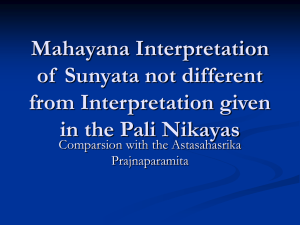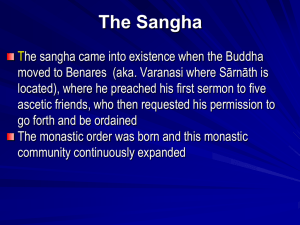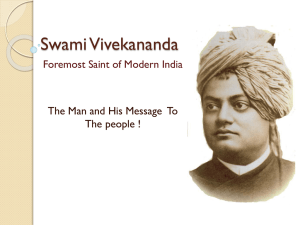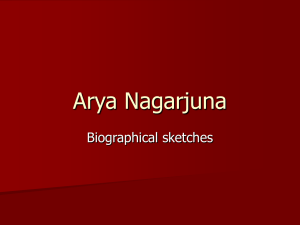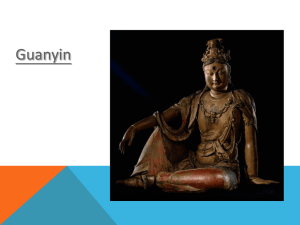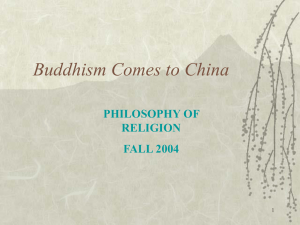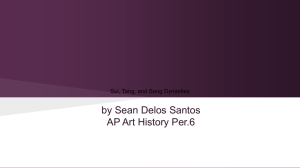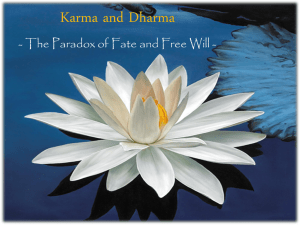How the Middle Path Has become a Sunyata Doctrine
advertisement
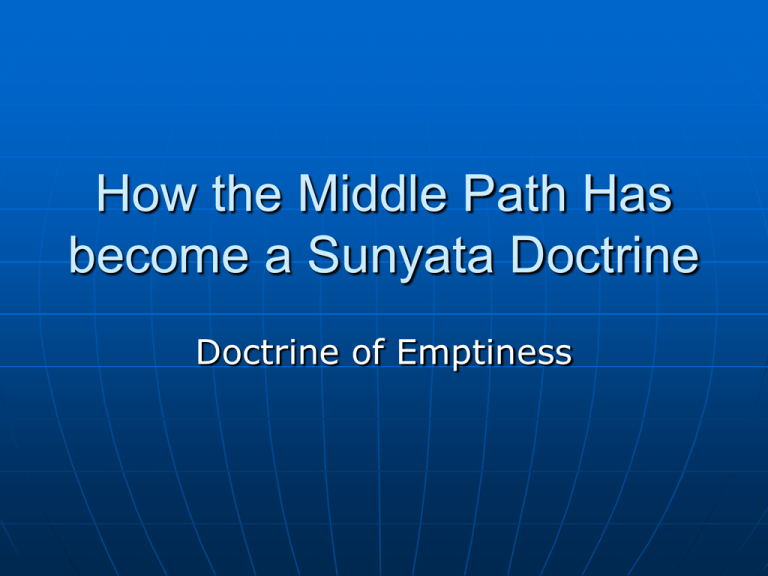
How the Middle Path Has become a Sunyata Doctrine Doctrine of Emptiness Middle Path- Sunyata Paticcasamuppada known as theory of Cause (Hetu) and Effect (Phala). This hetu and phala become the other way of Hetu and Phala means Avijja paccaya sankhara becomes sankhara paccaya avijja. If so that hetu Phala will not remains as hetu and phala any more. Middle Path - Sunyata If anything is dependently originated that thing does not have its own intrinsic nature (Svatantra). That is dependent always and exists when only the causes are there. The meaning of Sunyata is empty of its intrinsic nature. Middle Path - Sunyata That is the reason Nagarjuna mentioned “Yah pratitya samutpadah sunyatam tam pracaksmahe” (If anything is dependently originated.) This primary concept has been provided for Arya Nagarjuna by the Prajnaparamita literature. Middle path-Sunyata Prajnaparamita literature explains the sunyata (emptiness) and its main theme is sunyata. According to the Prajnaparamita literature prajna means realization of sunyata. In order to realize that sunyata one has to devoid of view of Atman. In the same way Arya Nagarjuna pada using the theory of Pratityasamutpada Explained the relativity of all dharmas (Sarva dhama) Sunyata. Middle Path - Sunyata The name Madhyamaka is given for this theory. This name has given by Arya Nagarjuna. On this theory Madhyamaka Philosophy has been built up. This name is given for Middle Path for the Practice in Middle. Middle Path - Sunyata Analysis of meaning of the Concept of Sunyata In order to draw the meaning of Sunyata one has to go to the Early Buddhism. Later on this concept of Sunyata has been philosophically explained. Middle Path - Sunyata This “Sunyata” word has explained in Pali as “Sunnata”. This Sunnata has properly defined in Pali Nikayas. This primarily we can see in two occasions. One occasion is in the Samyutta Nikaya how the Asankhatagami magga (Uncondition Path) explained. Middle Path - Sunyata (Katamoca bhikkhave asankhatagami maggo. Sunnata samadhi, Animitta samadhi and Appanihita samadhi. Ayam vuccati bhikkhave Asankhata – gami maggo). “Monks, what is Asankhatagamimagga (uncondition Path). That is Sunnata Samadhi Middle path - Sunyata (Concentration on Emptiness), Animitta samadhi (Concentration on Signlessness), Appanihita samadhi (Concentration on wishlessness). This is the Asankhatagami magga. (S.IV.360). In order to achieve these concentrations the methods of Middle Path - Sunyata Meditations also have been pointed out. Those are: 1. By Anatta Bhavana – Sunnata Samadhi 2. By Dukha Bhavana - Appanihita samadhi 3. By Anicca Bhavana - Animitta samadhi Midde Path - Sunyata Here it as been indicated that to realize Sunnata one has to have Anatta bhavana. This has been further elaborated in the Mogharaja Manava Puccha in Sutta Nipata. Middle Path - Sunyata “Sunnato lokam avekkhassu Mogharajo sada sato Attanuditthim uhacca Evam maccutaro siya Evam lokam avekkhantam Maccuraja na passati” (Moghraja with ever mindfulness you Middle Path - Sunyata Have to see the world. (What kind of mindfulness?), You must get rid of atta-ditthi (Self-view). By this way you can cross over the Mara. If anyone sees the Loka (world) by this way, the king of the death (Maccaraja)will not see him. In here very important Idea has given Middle path- Sunyata That is the Sunyata means to get rid of self-view. In order to get rid of self view one has to have Prajna (Wisdom). Without prajna no one will be able to realize Anicca (Impermanency), Dukkha (Suffering) and non-self (Anatta). Middle Path - Sunyata That has been mentioned in the Dhammapada. 1.Sabbe sankhara aniccati Yada pannaya passati Atha nibbindati dukkhe Esa maggo visuddhiya. 2. Sabbe sankhara dukkhati…………. 3. sabbe Dhamma anattati……………. Middle Path - Sunyata (If anyone views all conditioned things are anicca (Impermanent) then he becomes disgusted with the suffering (Dukkha).This is the path to purify). This clearly shows that to realize imparmanency, suffering and non-self one has to have Prajna (wisdom). Middle Path - Sunyata Mahayanists saw these factors clearly and to explain that they have started literature in the name of Prajnaparamita (Perfection of Wisdom). For this literature of discourses (Sutras) they named Prajnaparamita in order to show the importance of Middle Path - Sunyata Prajna and to show the Prajnaparamita which has to develop by a Bodhisattva to become a Buddha. Though it has explained in early Buddhism the importance of Panna in order for the realization of Nibbana, Mahayanikas attempted to Middle Path - Sunyata Show it through the Prajnaparamita literature. Mahayanists in their Sutras explained only the Bodhisattva practice and explained the Prajnaparamita as the special paramita that the Bodhisatta has to practice. Middle Path - Sunyata There are about 27 Prajnaparamita Sutras and the original sutras only about few of them and we come across others appear in there Chinese and Tibetan translations. Among those Astasahasrika Prajnaparamita considered as the Earliest one. Middle Path - Sunyata Because of the validity of this Sutra as an earliest one Arya Nagarjuna also written a commentary in the name of Mahaprajnaparamita sastra. This sutra especially discusses the full-filling of prajnaparamita by the Bodhisattva. Middle Path - Sunyata In this Sutra mentions six Paramitas that the Bodhisattva has to practice. Those are Dana (Generosity),Sila (Morality), Ksanti (Patience), Virya (Effort), Dhyana (Concentration) Prajna (Wisdom). When fulfilling these Paramitas Mddle Path - Sunyata Prajna paramita will be the primary Paramit and witout the connection of Prajna paramita the other paramtas even do not get the name Paramita. “Sarvasu kausika satsu paramitasu bodhisatto Mahasatvanscarati. Api tu khalu punah kausika PrajnaparamiTaiva atra purvangama. Bodhisattvasya Mahasattvasya Middle Path - Sunyata Danam va dadatah, Silam va raksatah, ksantam va sampadayamansya, Viryam va Arabhamanasya, dhyanam a sampadayamanasya,dharma va vipasyatah, Bodhisattasya Maha sattvasya prajnaparamiaivatra purvangama. Na ca kausika asam Mddle Path - Sunyata Sannam paramitanam mupayakausalya parigrahitanam prajnaparamita parinamitanam Sarvajnata parinamitanam visesah na ca na na karanam upalabhyate”. (The Buddha says, Kausika, the Bodhisattva the great being, walks in all these perfections. But Kausika Middle Path - Sunyata Here the Praqjnaparamita will be the predecessor. When the Bodhisattva offers things, protect morals, patience is procured, efforts starts, Enters to the attainments, when seen the Dharmas through the insight, Prajnaparamita will be the predecessor for the Bodhisattva and Middle Path - Sunyata And the Great being (Mahasattva). Kausika, when these six Paramitas are grasped by the skillfulness and the Prajnaparamita and bending towards all knowledge these two are not sepwerate things and there is no difference between these two). In this manner it is mentioned that Middle Path - Sunyata The Bodhisattva should necessarily practice the six perfections and in all these paramitas Prajnaparamita will be the predecessor. Why it is said that the Pranaparamita should become a predecessor? That is because the selflessness will be realized by the Prajna. That itself is the Sunyata. Midle Path - Sunyata “Sunya eva bhagavan sarva dharmas tathagatenakhyatah. (Lord Buddha, everything is sunya and this has been said by the Tathagata). By this way it has been said that the sunya is the nature of everything. The Buddha has explained the Dharmata (Nature) of everything. Middle Path - Sunyata The nature of everything is inexpressable (anabilapya). (Sa ca sarvadharmanam dharmata anabhilapya). What has been expressed by the Buddha as Sunya, that is infinite (Aprameya), that is not decaying (Aksaya), (Ya ca Subhute sunyam Middle Path - Sunya Aksaya api te). If anything is sunya that is Aprameya. If anything is sunya that is Aksaya. Here the meaning is not different. The Buddha has expressed Dharmas. They are aprameya (there is no limit) Asankheyya (uncountable), Aksaya Middle Path - Sunyata (not decaying), Sunya (Empty), Animitta (Signlessness),Appanihita (wishlessness) Anabhisankara (uncondition),Anutpada (un-born). Ajatha( not produced) Abhava (nonbecoming), Viraga (Absence of desire) Nirdha (Absence of desire), Nirodha (Ceasing) Nirvana. Middle Path - Sunyata But dharmata of all Dharmas are inexpressable. Why? If there is any Sunyata that is inexpressable. (Sarvadharma api subhute anabhilapyah. Tat kasya hetoh? Ya ca Subhute sarvadharmanam Sunyata, na sa sakya abhilapitum).
